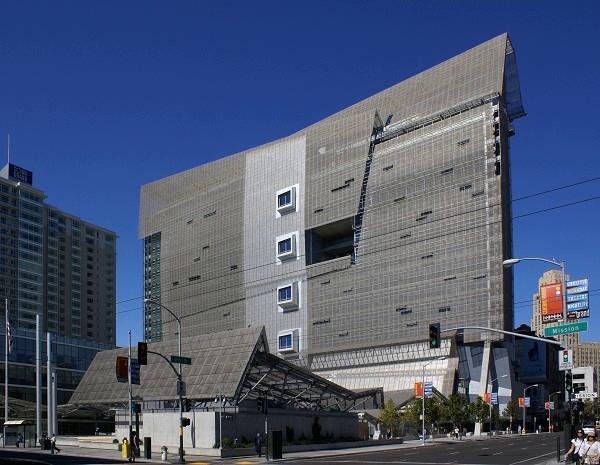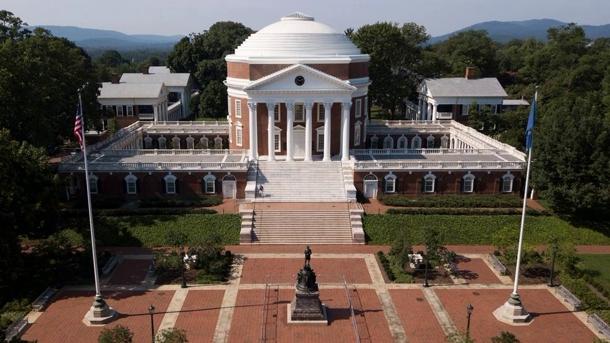Kunstler: We’re In The “Pause Between Past & Future Deep State Seditions”
Authored by James Howard Kunstler via Kunstler.com,
Executive Order
In this pause between past and future Deep State seditions, and the full-blown advent of Corona Virus in every region of the world, we pause to consider Mr. Trump’s executive order requiring new federal buildings to be designed in the classical style.
Federal Building San Francisco by Thom Mayne
The directive has caused heads to explode in the cultural wing of Progressive Wokesterism, since the worship of government power has replaced religion for them and federal buildings are their churches — the places from which encyclicals are hurled at the masses on such matters as who gets to think and say what, who gets to use which bathroom, and especially whose life and livelihood can be destroyed for being branded a heretic.
The religion of Progressivism (under various names) has been growing for over a century, based on the idea that the material abundance of techno-industrial societies should be centrally managed by national bureaucracies, finally leading to a nirvana of perfect fairness. The part that’s always left out is that this is accomplished by coercion, by pushing people around, telling them what to do and how to think, and by confiscating their property or docking their privileges if they seem to have too much of either. You can observe the operations of this doctrine in the current crop of Democratic Party aspirants to the White House.
The architecture that expressed all that is loosely called “Modernism” mostly because it was supposed to represent the distilled essence of everything that is up-to-date, and the idea of coercing an unfair world toward universal fairness has ruled the elite managerial class ever since Karl Marx lanced his boils of social grievance on the printed page. The First World War really sealed the deal for Modernism. The industrial-scale slaughter — well-depicted in the recent movie, 1917 — so horrified the elites that the architecture branch of elite-dom decided to shit-can all the offensive claptrap of history as expressed in buildings and replace them with bare boxes of one kind or another. A whole metaphysical theology was constructed to justify this attempt at a totalistic do-over for the human race. “Less is more…” et cetera.
Meanwhile, along came Stalin and Hitler who persisted in the dirty business of neoclassical architecture, and they screwed the pooch on that theme for all time, while the Second World War reaffirmed the urge to cleanse the world of all that filthy symbolism. By the 1950s, Modernism ruled the scene as the architecture of Decency and Democracy. It very quickly became the architecture that glorified corporate America, viz, the rows of glass box skyscrapers hoisted up along the grand avenues of midtown Manhattan, and then every other city center in America. Before long, as the old government buildings of yore grew obsolete, they too were replaced with confections of Modernism, and then the university libraries, and finally… everything.
The trouble with being up-to-date in architecture is that buildings last a long time and dates fade into history, and if you hate history you have created a problem. The world is a restless place. The main feature of this particular moment is that techno-industrial society has entered an epochal contraction presaging collapse due to over-investments in hyper-complexity. That hyper-complexity has come to be perfectly expressed in architecture lately in the torqued and tortured surfaces of gigantic buildings designed by computers, with very poor prospects for being maintained, or even being useful, as we reel into a new age of material scarcity and diminished expectations — especially the expectation for reaching that technocratically engineered nirvana of fairness.
Of course, the mandarin uber-class among the elite, especially the poohbahs in the architecture schools, can’t bear the thought that things are tending this way. Their theology of up-to-date-ness, of “the cutting edge,” is all about fashion. That things go out of fashion has given them the opportunity to create and cash-in on ever more new fashions, to keep up the pretense of perpetually surfing that cutting edge, from which they derive their status. And this incessant reach for status, and the power it confers, belies and betrays the whole business of representing the ultimate nirvana of fairness, revealing them to be the mendacious frauds they are.
The Trumpian reach backward toward classicism is certainly a quixotic move, even though one can make a case for it being a national style, at least in the early years of the USA when that mode of building was supposed to represent the democracy of ancient Greece and the dignity of the Roman republic — hence, Greco-Roman architecture. Some things to consider: We’re going to have to reduce the scale of the things we build. The cutting edge grandiosity of today is about to go of style. National bureaucracies will shrink, if they don’t vanish altogether, and so will the buildings that house their operations.
We’re going to need buildings that don’t go out of style, so you can forget about the cutting edge, and classicism does have the virtue of timelessness — or at least it did, for a long time. These new buildings ought to have the capacity for adaptive re-use over generations, even centuries. They will probably have to be made out of non-exotic materials, namely, masonry and wood, since the scarcities we face will include a lot of modular fabricated materials ranging from plate glass to aluminum trusswork to steel I-beams, to sheetrock — all things requiring elaborate, complex mining and manufacturing chains.
A virtue of classicism is that it employs structural devices that allow buildings to stand up: arches, columns, colonnades. These are replicable in modules or bays along scales from small to large. These devices honestly express the tectonic sturdiness of a building within the realities of gravity. A hidden virtue of classicism is that it is based on the three-part representation of the human figure: the whole and all the parts within it exist in nested hierarchies of base-shaft-and-head. This is true of columns with capitols set on a base, of windows with their sills, sashes, and lintels, and the whole building from base to roof. Classical architecture follows proportioning systems universally found in nature, such as the Fibonacci series of ratios, which are seen in everything from the self-assembly of seashells to the growth of tree branches. Thus, classicism links us to nature and to our own humanity.
University of Virginia by Thomas Jefferson
Classical ornament — the swags, moldings, entablatures, cartouches, corbels, festoons, and what-have-you — are not mandatory, but, of course, they also provide a way of expressing our place in nature, which is a pathway to expressing truth and beauty.
Modernism doesn’t care about truth and beauty; it cares about power, especially the power to coerce. The main imperative of Modernism was to separate us from nature, since it was human nature that brought about all the horrors of the 20th century and so revolted the intellectual elites. The result of that was a denatured architecture of the machine and an animus against what it means to be human located in nature.
We’re probably not going back to anything like formal classicism because the contraction ahead will leave us in a world of salvage, of cobbling together whatever we can from the detritus left over. But sooner or later — surely well after Mr. Trump has decomposed into his constituent molecules — we will get back to an architecture that is based on our place in nature, so don’t set your hair on fire over this new executive order, no matter how much The New York Times wants you to.
Tyler Durden
Mon, 02/10/2020 – 15:35
via ZeroHedge News https://ift.tt/2UF3Ked Tyler Durden

